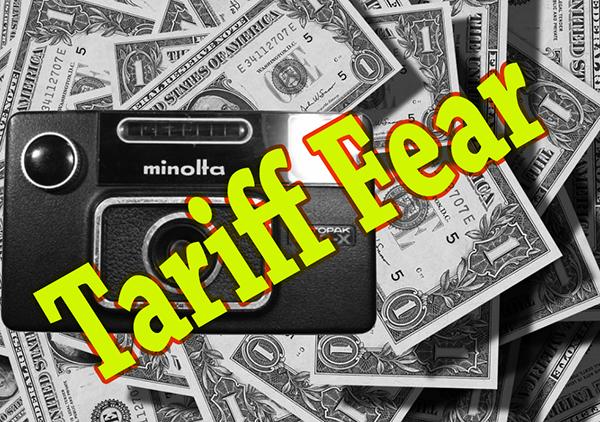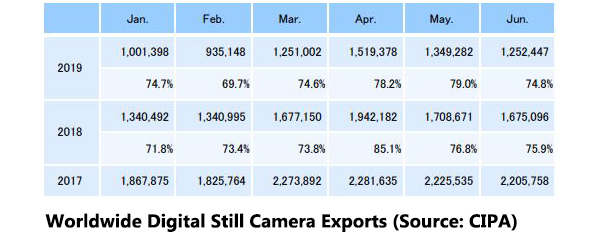Will U.S. Tariffs Against China Drive Up Camera Prices?

The U.S. tariffs that recently have been threatened or imposed against China by President Donald Trump will doubtlessly affect the photo industry in one way or another. Many of us are concerned that we may be paying more for our camera gear in the future. Just how likely are price increases, and are rising costs the only things that should make us nervous?
To be clear, I am not an economist—not even close. But then again neither are some of the people in Washington who are making the trade decisions that impact us all. I did spend a large portion of my life as a senior executive with a major Japanese camera company, and I know what’s behind the curtain. I’ve been in those smoke-filled meetings in Osaka where crucial decisions are made, and I’ve contributed to their direction.
Tariffs are taxes levied on imported goods. They are paid to our federal government by the importers. The original purpose of tariffs was to raise money to run the country. They also have been used to balance out the cost difference between imported and domestically produced goods so that the stuff we make here at home is more attractive (i.e., cheaper) and presumably sells in greater volume than the imported stuff. In the consumer electronics industry, the tariffs have historically been ad valorum, which means that they’re calculated as a percentage of the cost of the goods, sort of like the way state sales tax works.
Tariffs can be imposed to penalize the exporting nation, or as a haphazard negotiating tool, a tactic that can have unintended consequences.
As I see it, the real danger of the current tariff barrage is not increased prices on the large volume of photo-related merchandise flowing in from China.
Since all major Japanese electronics companies in the U.S. operate as sales subsidiaries of their Asian parent, I predict that they will use a combination of Landed Cost Adjustment (the price the U.S. subsidiary pays) and compressed Marginal Profit (the consolidated Gross Profit generated by the factory, headquarters export division and sales subsidiary) to keep the Dealer Net about the same, despite the tariff that the subsidiary is required by law to pay.
If this happens, there is no financial reason for the reseller (camera store) to increase the actual selling price. The consumer should continue to pay the same amount.
Why would the manufacturer be willing to take a hit on their profit? To keep an already flagging category stable. The digital camera market is declining and may not survive a round of price increases.
And of course, if only one manufacturer raised prices, they would lose Market Share to the others who found a way to weather the storm without increasing prices—particularly those who do the bulk of their fabrication in other Asian nations instead of China.
But this strategy comes at severe and brutal cost to the photo industry as a whole.
One problem is that Marginal Profit is already very small. Consumers constantly demand more features for the same (or less) money. When manufacturing costs go up but the selling price remains the same, profit margins shrink.
Photo manufacturers originally went offshore to Malaysia, Indonesia, Vietnam or China to gain a competitive cost advantage. But now nearly everyone does some production offshore, so all that has happened is that they have unwittingly lowered the bar. What started as a race to make higher profits ended as a struggle to remain competitive.

But the more serious negative factor, which we alluded to above, is the sluggish camera market. Year-over-year sales (and subsequent net profit) of hobbyist photo goods are already in a slump. Official export figures collected by CIPA (Camera & Imaging Products Association) show that camera exports in 2019 vs. 2018 and especially 2017 are in a tailspin. Interchangeable lenses, which held their ground much of 2018, are likewise in the tank.

Making a long story short, the real consequences of the tariff could be 1) major companies abandoning the photo arena entirely, 2) fewer camera models and less frequent new model introductions, and 3) general malaise settling in over the entire photo industry causing less innovation, lower overall consumer appeal and disappearance of third-tier and some second-tier manufacturers.
It's a lot to worry about. But we’re not through.
If the U.S. is the only country with a tariff there will no longer be worldwide pricing parity. Companies try very hard to create an environment that permits more-or-less uniform pricing around the globe. It’s a global market, and anyone with a smartphone can find out the price of a commodity anywhere—for example, the cost of fish in Sweden.
When worldwide pricing becomes striated, Gray Market goods begin to appear in the country that has the highest prices.
To avoid Gray Market flow, manufacturers would have to set prices in Europe and Japan artificially high; otherwise some “sideways distributors” might import directly from Japan or Europe and sell the product to USA dealers at noncompetitive prices. Theoretically the Gray imports would be subject to tariff duties too, but some might find ways to avoid paying it when purchasing in small quantities. (You’re saying, “That’s illegal” and I’m replying, “Don’t be naive.”)
This is all just speculation, you understand. I’ve already made it clear that I am not an economist and I no longer exert any influence on the world stage. Personally I’m willing to pay a percentage more for the lenses or camera body I may purchase over the next 12 months as long as I can still enjoy the stupendously broad range of products to choose from.
If the cost of a cone goes from 90¢ to a dollar I won’t complain, just as long as there are still 31 flavors of ice cream for me to choose from.
—Jon Sienkiewicz
- Log in or register to post comments
















































